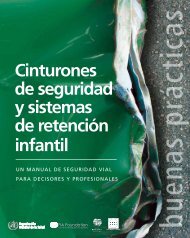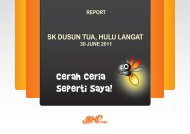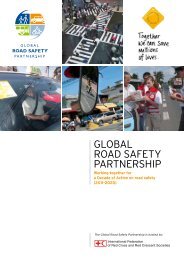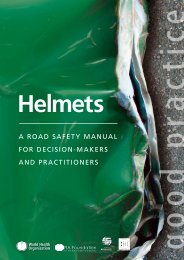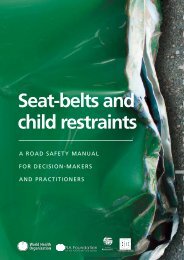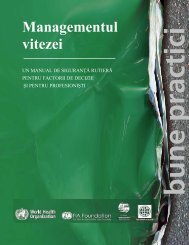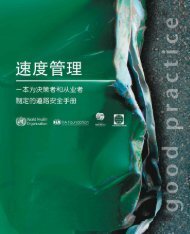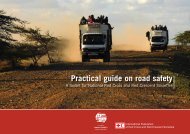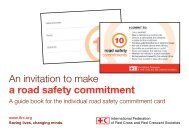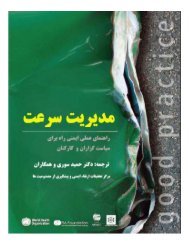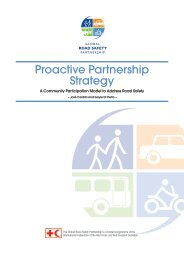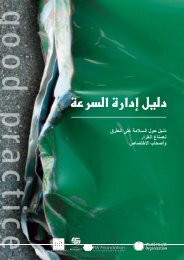How to design and implement a drinking and driving programme pdf ...
How to design and implement a drinking and driving programme pdf ...
How to design and implement a drinking and driving programme pdf ...
Create successful ePaper yourself
Turn your PDF publications into a flip-book with our unique Google optimized e-Paper software.
Module 3: <strong>How</strong> <strong>to</strong> <strong>design</strong> <strong>and</strong> <strong>implement</strong> a <strong>drinking</strong> <strong>and</strong> <strong>driving</strong> <strong>programme</strong><br />
• 3.4 Social marketing <strong>and</strong> public education: This section shows how mass media<br />
campaigns can increase public knowledge about legislation <strong>and</strong> raise awareness of<br />
increased enforcement. The objectives <strong>and</strong> target group of such a mass media campaign<br />
should be clearly identified, <strong>and</strong> advertising <strong>and</strong> public relations specialists<br />
should be employed <strong>to</strong> create targeted campaign messages <strong>and</strong> materials. The effects<br />
of the mass media element of the <strong>drinking</strong> <strong>and</strong> <strong>driving</strong> campaign on the opinions<br />
<strong>and</strong> behaviour of road users should be closely moni<strong>to</strong>red <strong>and</strong> evaluated, <strong>and</strong> lessons<br />
learned should be used <strong>to</strong> improve the quality <strong>and</strong> impact of future campaigns.<br />
• 3.5 Community-based interventions: Drinking <strong>and</strong> <strong>driving</strong> interventions<br />
undertaken by <strong>and</strong> involving the local community can be effective in educating<br />
the public about the risks involved in <strong>drinking</strong> <strong>and</strong> <strong>driving</strong>, <strong>and</strong> preventing it from<br />
taking place. This section highlights the interventions of voluntary organizations<br />
created specifically <strong>to</strong> prevent <strong>drinking</strong> <strong>and</strong> <strong>driving</strong>, <strong>to</strong> <strong>programme</strong>s undertaken by<br />
employers, schools, outlets selling alcohol, <strong>and</strong> <strong>design</strong>ated-driver <strong>programme</strong>s.<br />
• 3.6 Engineering interventions: This section looks at the benefits of engineering<br />
interventions <strong>to</strong> prevent crashes involving <strong>drinking</strong> <strong>and</strong> <strong>driving</strong>. These include<br />
reducing roadside hazards for drivers <strong>and</strong> pedestrians, lower speed limits, better<br />
lighting, “refuge isl<strong>and</strong>s” <strong>to</strong> allow staged road crossing, <strong>and</strong> improved pedestrian<br />
signals at traffic lights.<br />
• 3.7 Ensuring an appropriate medical response: In planning a <strong>drinking</strong> <strong>and</strong><br />
<strong>driving</strong> <strong>programme</strong> it is also important <strong>to</strong> consider the ability <strong>to</strong> respond <strong>to</strong><br />
crashes that involve victims who are impaired by alcohol. This means taking in<strong>to</strong><br />
consideration the capacity <strong>to</strong> provide an appropriate first aid response <strong>and</strong> addressing<br />
existing pre-hospital care <strong>and</strong> trauma care systems.<br />
BOX 3.1: The Polish national road safety <strong>programme</strong> (GAMBIT 2005)<br />
1. Revise laws on <strong>drinking</strong> <strong>and</strong> <strong>driving</strong>:<br />
• <strong>to</strong> modify drink-<strong>driving</strong> <strong>and</strong> drug-<strong>driving</strong> laws.<br />
2. Improve public education <strong>and</strong> communications <strong>to</strong> raise awareness of the role of alcohol in crashes:<br />
• <strong>to</strong> nurture, through school education, negative attitudes <strong>to</strong> <strong>driving</strong> while under the influence of alcohol<br />
or similar substances;<br />
• <strong>to</strong> make “sober <strong>driving</strong>” part of driver training;<br />
• <strong>to</strong> introduce systematic drink-drive campaigns.<br />
3. Improve enforcement of <strong>drinking</strong> <strong>and</strong> <strong>driving</strong> laws:<br />
• <strong>to</strong> provide road traffic enforcement services with devices for recording <strong>and</strong> testing drivers for alcohol<br />
<strong>and</strong> other substances;<br />
• <strong>to</strong> improve r<strong>and</strong>om driver-sobriety checks as a st<strong>and</strong>ard test procedure;<br />
• <strong>to</strong> introduce r<strong>and</strong>om checks on drivers for substances other than alcohol;<br />
• <strong>to</strong> promote vehicle devices that record <strong>and</strong> test drivers after they have been <strong>drinking</strong>.<br />
4. Conduct systematic studies of road use while under the influence of alcohol or other substances:<br />
• <strong>to</strong> develop a system for moni<strong>to</strong>ring the problem of drivers using roads under the influence of alcohol<br />
or other substances;<br />
• <strong>to</strong> study the effectiveness of schemes <strong>design</strong>ed <strong>to</strong> reduce the number of road users under the influence<br />
of alcohol.<br />
Source: Polish National Road Safety Council<br />
50



